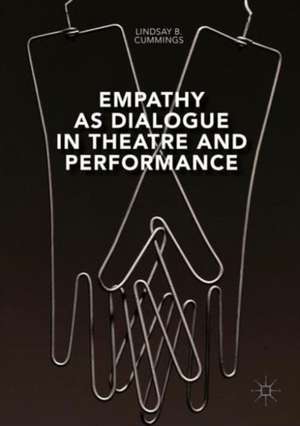Empathy as Dialogue in Theatre and Performance
Autor Lindsay B. Cummingsen Limba Engleză Hardback – 28 iul 2016
| Toate formatele și edițiile | Preț | Express |
|---|---|---|
| Paperback (1) | 579.02 lei 6-8 săpt. | |
| Palgrave Macmillan UK – 30 mai 2018 | 579.02 lei 6-8 săpt. | |
| Hardback (1) | 583.28 lei 6-8 săpt. | |
| Palgrave Macmillan UK – 28 iul 2016 | 583.28 lei 6-8 săpt. |
Preț: 583.28 lei
Preț vechi: 686.21 lei
-15% Nou
Puncte Express: 875
Preț estimativ în valută:
111.62€ • 115.83$ • 93.30£
111.62€ • 115.83$ • 93.30£
Carte tipărită la comandă
Livrare economică 15-29 martie
Preluare comenzi: 021 569.72.76
Specificații
ISBN-13: 9781137593252
ISBN-10: 1137593253
Pagini: 211
Ilustrații: VII, 220 p.
Dimensiuni: 148 x 210 x 19 mm
Greutate: 0.4 kg
Ediția:1st ed. 2016
Editura: Palgrave Macmillan UK
Colecția Palgrave Macmillan
Locul publicării:London, United Kingdom
ISBN-10: 1137593253
Pagini: 211
Ilustrații: VII, 220 p.
Dimensiuni: 148 x 210 x 19 mm
Greutate: 0.4 kg
Ediția:1st ed. 2016
Editura: Palgrave Macmillan UK
Colecția Palgrave Macmillan
Locul publicării:London, United Kingdom
Cuprins
Introduction.- Acknowledgements.- Chapter 1. Interruptions.- Chapter 2. Repetitions.- Chapter 3. Rehearsals.- Chapter 4. Empathic Economies.- Conclusion.- Bibliography.
Notă biografică
Lindsay B. Cummings is Assistant Professor ofDramatic Arts at the University of Connecticut, USA.
Textul de pe ultima copertă
Empathy has provoked equal measures of excitement and controversy in recent years. For some, empathy is crucial to understanding others, helping us bridge social and cultural differences. For others, empathy is nothing but a misguided assumption of access to the minds of others. In this book, Cummings argues that empathy comes in many forms, some helpful to understanding others and some detrimental. Tracing empathy’s genealogy through aesthetic theory, philosophy, psychology, and performance theory, Cummings illustrates how theatre artists and scholars have often overlooked the dynamic potential of empathy by focusing on its more “monologic” forms, in which spectators either project their point of view onto characters or passively identify with them. This book therefore explores how empathy is most effective when it functions as a dialogue, along with how theatre and performance can utilise the live, emergent exchange between bodies in space to encourage more dynamic, dialogic encounters between performers and audience.




























